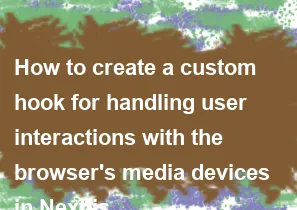How to create a custom hook for handling user interactions with the browser's media devices in Next.js

To create a custom hook for handling user interactions with the browser's media devices (such as the webcam and microphone) in a Next.js application, you can follow these steps:
Set up your Next.js project: If you haven't already, create a Next.js project using
create-next-appor any other method you prefer.Install necessary dependencies: You'll need to install
react,next, and any other dependencies required for your project.Create the custom hook: You can create a custom hook to handle user interactions with media devices. Here's a basic example:
javascript// hooks/useMediaDevices.js
import { useState, useEffect } from 'react';
const useMediaDevices = () => {
const [mediaDevices, setMediaDevices] = useState([]);
useEffect(() => {
const getMediaDevices = async () => {
try {
const devices = await navigator.mediaDevices.enumerateDevices();
setMediaDevices(devices);
} catch (error) {
console.error('Error enumerating media devices:', error);
}
};
getMediaDevices();
// Cleanup function
return () => {
// Clean up any resources if needed
};
}, []);
return mediaDevices;
};
export default useMediaDevices;
- Use the custom hook in your Next.js pages or components: You can import and use the custom hook in your pages or components to access the media devices.
javascript// pages/index.js
import React from 'react';
import useMediaDevices from '../hooks/useMediaDevices';
const IndexPage = () => {
const mediaDevices = useMediaDevices();
return (
<div>
<h1>Media Devices</h1>
<ul>
{mediaDevices.map(device => (
<li key={device.deviceId}>{device.label}</li>
))}
</ul>
</div>
);
};
export default IndexPage;
Style and handle interactions: You can style your components and handle interactions as needed based on the devices available.
Test and handle permissions: Ensure that your application handles user permissions properly when accessing media devices. Users should be prompted to allow or deny access to their devices.
Remember to handle errors and edge cases appropriately, and consider additional features such as starting/stopping media streams, handling different device types, and error handling for unsupported browsers.
-
Popular Post
- How to optimize for Google's About This Result feature for local businesses
- How to implement multi-language support in an Express.js application
- How to handle and optimize for changes in mobile search behavior
- How to handle CORS in a Node.js application
- How to use Vue.js with a UI framework (e.g., Vuetify, Element UI)
- How to configure Laravel Telescope for monitoring and profiling API requests
- How to create a command-line tool using the Commander.js library in Node.js
- How to implement code splitting in a React.js application
- How to use the AWS SDK for Node.js to interact with various AWS services
- How to use the Node.js Stream API for efficient data processing
- How to implement a cookie parser middleware in Node.js
- How to implement WebSockets for real-time communication in React
-
Latest Post
- How to implement a dynamic form with dynamic field styling based on user input in Next.js
- How to create a custom hook for handling user interactions with the browser's device motion in Next.js
- How to create a custom hook for handling user interactions with the browser's battery status in Next.js
- How to implement a dynamic form with dynamic field visibility based on user input in Next.js
- How to implement a dynamic form with real-time collaboration features in Next.js
- How to create a custom hook for handling user interactions with the browser's media devices in Next.js
- How to use the useSWRInfinite hook for paginating data with a custom loading indicator in Next.js
- How to create a custom hook for handling user interactions with the browser's network status in Next.js
- How to create a custom hook for handling user interactions with the browser's location in Next.js
- How to implement a dynamic form with multi-language support in Next.js
- How to create a custom hook for handling user interactions with the browser's ambient light sensor in Next.js
- How to use the useHover hook for creating interactive image zoom effects in Next.js